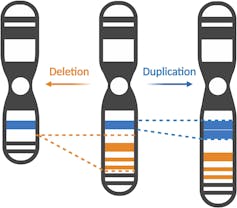Genetic inheritance may sound straightforward: One gene causes one trait or a specific illness. When doctors use genetics, it’s usually to try to identify a disease-causing gene to help guide diagnosis and treatment. But for most health conditions, the genetics is far more complicated than how clinicians are currently looking at it in diagnosis, counseling and treatment.
Your DNA carries millions of genetic variants you inherit from your parents or develop by chance. Some are common variants, shared by many people. Others are rare variants, found in very few people or even unique to a family. Together, these variants shape who you are – from visible traits such as height or eye color to health conditions such as diabetes or heart disease.
In our newly published research in the journal Cell, my team and I found that a genetic mutation involved in neurodevelopmental and psychiatric conditions such as autism and schizophrenia is affected by multiple other genetic variants, changing how these conditions develop. Our findings support the idea that, rather than focusing on single genes, taking the whole genome into account would provide insight into how researchers understand what makes someone genetically predisposed to certain diseases and how those diseases develop.
Table of Contents
Primary and secondary variants
Certain rare variants can cause problems on their own, such as the genetic mutations that cause sickle cell anemia and cystic fibrosis. But in many cases, whether someone actually develops symptoms of disease depends on what else is happening across the genome.
While a primary variant might trigger a disease, secondary variants can alter how that disease develops and progresses. Think of it like a song: The melody (primary variant) is the main part of the song, but the bassist and drummer (secondary variants) can change its groove and rhythm.
That’s why two people with the same genetic mutation can seem so different. One person might have severe symptoms, another person mild symptoms, and another none at all. These variations can even occur within the same family. This phenomenon, called variable expressivity, arises from differences in the secondary variants a person has. In most cases, these variants amplify the effects of the primary mutation. A higher number of secondary variants on top of a primary variant generally leads to more severe disease.
Sometimes, a primary variant and a secondary variant together can cause two different disorders in the same person, such as Prader-Willi syndrome and Pitt-Hopkins syndrome. Other times, secondary variants have no obvious effect on their own but together can tip the balance of whether and how a disease will appear, even in the absence of a primary variant. This can be seen in the development of heart disease in children.
Insights from a missing piece of a chromosome
My team and I studied a genetic change known as a 16p12.1 deletion, where a small piece of chromosome 16 is missing. Researchers have linked this mutation to developmental delay, intellectual disability and psychiatric conditions such as schizophrenia. Yet most children inherit this genetic variant from a parent who has milder symptoms, different symptoms or sometimes no symptoms at all.
To understand why this happens, we analyzed 442 individuals from 124 families carrying this genetic mutation. We found that children lacking this piece of chromosome 16 had more secondary variants elsewhere in the genome compared to their carrier parents. These secondary variants took many forms, including both small changes and large deletions, duplications and expansions of their DNA.
Gandawijaya et al./Biorender via Frontiers in Cellular Neuroscience, CC BY-SA
Each type of secondary variant was associated with different health outcomes. Some were linked to smaller head size and reduced cognitive function, while others contributed to higher rates of psychiatric or developmental symptoms. This suggests that while a 16p12.1 deletion makes the genome more sensitive to neurodevelopmental disorders, which symptoms manifest depends on which other variants are present.
The story gets even more complex when considering the fact that children not only inherit a 16p12.1 deletion from one parent but also inherit secondary variants from both parents.
My team and I found that the symptoms of the parent with this genetic mutation often match those of their spouse. For example, a parent with a 16p12.1 deletion who shows signs of anxiety or depression is more likely to have a partner who also has these symptoms. This pattern, called assortative mating, means that when parents with overlapping genetic risks have children, those risks can combine and accumulate.
Over generations, this stacking of secondary variants can lead to children who have more severe symptoms than their parents.
Biases in genetics research
One reason why scientific understanding of secondary variants has lagged is that genetic research often depends on who is recruited to participate in these studies and how researchers recruit them.
Most studies recruit patients affected with a particular disease. Families recruited from genetic clinics typically have children with severe versions of the disease. But if studies focus only on patients with the most acute symptoms, researchers may overestimate the effects of primary variants and miss the subtler role that secondary variants may play in how a disease develops.
But if researchers were to study people drawn from the general population – say, by recruiting people from a large shopping mall – some might carry the same primary variant but have far milder symptoms or none at all. This variability allows researchers to better dissect how different parts of the genome interact with each other and affect how a disease develops.
In our study, for example, we found that people with a 16p12.1 deletion who were recruited from the general population often had milder symptoms and different patterns of secondary variants compared to those who were recruited in a clinic.
Cavan Images/iStock via Getty Images Plus
Embracing complexity in genetics
Instead of a deterministic view where one mutation equals one outcome, a more complex model accounts for the fact that whether and how a disease develops depends on the interplay between different genetic variants and environment. This has implications for how genetics is used in the clinic.
Currently, a child who tests positive for a genetic variant might be diagnosed with a disease tied to that mutation. In the future, doctors might also examine the child’s broader genetic profile to better predict their developmental trajectory, psychiatric risk or response to therapies. Families could be counseled with a more realistic picture of their child’s probability of developing a disease, rather than assuming every person with the same genetic variant will share the same outcome.
The science is still emerging. Larger and more diverse datasets and models that can better capture the subtle effects of genetic variants and environmental factors are still needed. But what’s clear is that secondary variants are not secondary in importance.
By embracing this complexity, I believe genetics can move closer to its ultimate promise: not just explaining why disease happens, but predicting who is most at risk and personalizing care for each individual.
























